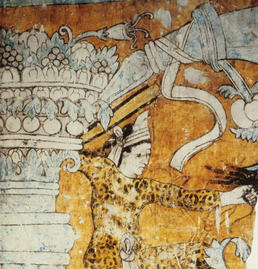Glocalization Processes in the Art of Religious Orders in the Early Modern Period
Project Head
Prof. Dr. Margit Kern
Research Fellows
Dr. Amrei Buchholz and Dr. Julia Kloss-Weber
Project Description
The encounter of missionary orders operating in worldwide networks with local cultures resulted, in the early modern period, in a flourishing production of artworks. The goal of the Research Unit “Glocalization Processes in the Art of Religious Orders in the Early Modern Period” is to analyse these visual media from a comparative perspective on the basis of various Latin American examples. The term “glocalization”, which derives from sociology, is employed here to describe the interferences of visual cultures to which global or local authority was attributed on the basis of specific hegemonic structures. Subproject 1 looks at the mission conducted in New Spain by the Franciscans, Augustinians and Dominicans in the 16th century, while Subproject 2 investigates the Jesuit reductions in the order’s former province of Paraquaria in the 17th and 18th century. Together the two subprojects thus permit a comparison between the use of images in the missions in the pre- and post-Tridentine era. In order to make the sociological model of glocalization (Robertson) operationalizable for art history, we shall draw for methodological assistance upon current theories of transcultural translation (Bachmann-Medick), which emphatically move away from the idea of frictionless transfers of meaning. A particular challenge in the context of our case studies is to ensure that, in analysing the dynamic structures of transcultural negotiations, we do not effectively bring them to a standstill and convert them into static models and descriptions of states. With this in mind, both subprojects focus upon concepts of space, images of the body and other performative practices. They thereby take as their central thesis the observation that these performative structures are to be understood as negotiation practices, and that the visual production issuing from them cannot be grasped in its full complexity if these practices are not taken into account. In other words, the performance dimensions inscribed into these artistic forms of expression positively demand concrete implementation of active participation. They must be understood as transcultural activities of translation, as translation movements. This also signifies taking the examination of transcultural aspects of mediality to a deeper level as a whole. We should not thereby look for culture-specific differences and record these in an essentializing manner, but describe and sketch the handling of these differences in processes of negotiation.





